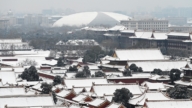【新唐人2014年11月27日讯】中共在西藏雅鲁藏布江干流上建设的第一座大型水电站——藏木水电站,日前正式投产发电。不过,这个水电项目却令不少环保人士和下游的印度等国感到不安。有水利工程专家表示,藏木水电站将会加速西藏高原升温。
据中共党媒《新华网》报导,23号下午,历时近8年、总投资96亿元、共6台机组,总装机容量51万千瓦的藏木水电站首台机组,正式投产发电。
藏木水电站位于海拔3300米以上的雅鲁藏布江中游、山南地区加查县境内,由中国华能集团公司投资、建设和运营,设计年发电量25亿千瓦时,是西藏第一座大型水电站。报导说,该电站第二台机组将于12月中旬发电,6台机组明年全部投产发电。
报导援引国家电网西藏电力有限公司董事长刘晓明的话说,藏木水电站的投产,将从根本上解决西藏中部电网的供电难题,特别是眼下正值冬季缺电。
不过,生活在德国的国际水资源问题、水利工程专家王维洛向《德国之声》指出,西藏其实并不缺电,而且开放西藏的太阳能和地热资源,应该优先于开放西藏的水资源。
王维洛表示,目前中国的科学家就雅鲁藏布江上的大坝对上游的影响认识不足,这种影响可能不堪设想,它可能会改变上游地区的降水,加速西藏高原升温。
据《新华网》去年1月的报导,中共国务院已批准在雅鲁藏布江中游建造三座新大坝,而这三个新批项目中的其中一个,其规模大于藏木水电站。
在雅鲁藏布江建坝,多年来一直引起处于下游的印度和孟加拉等国的关注。印度外长胡尔希德(Salman Khurshid)曾经要求中共“不得进行任何有损下游利益的活动”。
民间组织“绿色江河”副秘书长谭作人:“会有国际纠纷的,它是国际性的河流,在自然生态和社会问题上都会有一些问题的,下游的生活、生产、生态肯定都会受到影响的,因为水量减少了,上面蓄水嘛,上面的蓄水调剂是根据自己的需要,那对下游的考虑肯定会比较少的,这是现实存在的问题。”
据英国广播公司《BBC》报导,中共曾保证水电工程不会减少雅鲁藏布江的水量,因为设计的都是径流式水电站,没有蓄水功能,但这并没有减轻印度方面的担心。
报导还说,不少环保人士对中共在雅鲁藏布江流域兴建大型水电站持反对态度。他们担心,修建水坝将对该地区地壳的稳定产生影响,危及下游数以百万计的居民。
谭作人:“很多建设工程,包括工业的布局,水电的规划都是,只从利益集团的角度出发,对公共利益和对环境的后果,对社会的影响,它是不负责任的。”
王维洛表示,迳流式水电站确实对下游影响不大,但目前投产的藏木水电站是一座混凝土的重力坝,而且高度相当高,作为雅鲁藏布江上的首座大型拦水大坝,对下游肯定会有影响。
四川地质学者杨勇向《自由亚洲电台》表示,对雅鲁藏布江的水电开发要持谨慎态度。
杨勇指出,担心的问题是,藏木水电站是否意味着雅鲁藏布江全段流电站建设的开始,因为雅鲁藏布江的地质、生态更具有敏感性,对南亚地区的生态也至关重要。然而,包括环境、公众参与和有争议问题的相关信息,披露的非常少。
四川维权人士黄晓敏:“我现在还没有听说它的决策过程、选址,到它的施工,移民拆迁,包括今后的运作。我们应该记取中共历史早期的工程,包括现在的葛洲坝三峡电站的经验教训。”
王维洛还指出,国际科学家将地球升温两度视为地球生存极限,西藏高原在最近50年内升温已经超过两度,而藏木水电站的建成很可能加速这一现状。青藏高原不仅是印度马普特拉河的发源地,也是中国长江、黄河、澜沧江和怒江等大江大河的发源地。
因此,在王维洛看来,藏木水电站对中国人的影响,远远超过对印度的影响,只是印度可以发声,中国人不可以。
采访/秦雪 编辑/陈洁 后制/钟元
Tibetan Hydropower Station Accelerates Warming
Of Tibetan Plateau
The first large-scale hydropower station constructed
on Tibet’s Brahmahputra River, known as the Zangmu Dam,
began operation recently.
However, this hydropower project caused unease
among many environmentalists and countries downstream
such as India.
Some hydraulic engineering experts say that the Zangmu Dam
will accelerate the warming of the Tibetan plateau.
According to Chinese Communist Party (CCP) media “Xinhua",
the first generating unit of Zangmu Hydropower Station with a
total installed capacity of 510 Megawatts officially began
operating in the afternoon on the 23rd.
The project took 8 years, 9.6 billion yuan (US$ 150 million)
in investments and consists of 6 generating units.
Zangmu Dam is 3300 meters above sea level, constructed
on the middle reaches of the Brahmaputra River and is located
within the Gyaka county of Shannan prefecture.
The project is run and funded by the China Huaneng Group.
As the first large scale hydropower station in Tibet, the dam
generates 2.5 billion kW.h (kilowatt-hours) annually.
According to reports, the second generating unit will
begin operation in mid-December.
All 6 units will begin operation by next year.
Chairman Liu Xiaoming of State Grid’s Tibet Electric Power Co,
said that Zangmu Dam will fundamentally solve the problem of
power shortage in Central Tibet, which is especially
acute in winter.
However, German resident Wang Weiluo, an expert in
international water resource and hydraulic engineering
told “Deutsche Welle" that Tibet does not have a
power shortage in reality.
Furthermore, harnessing Tibet’s solar power and geothermal
resource should take precedence over Tibet’s hydropower.
Wang Weiluo said that currently, the Chinese scientists have
insufficient understanding of the impacts of dams on the
upper reaches of the Brahmaputra river.
These impacts can be disastrous.
The dam may alter the precipitation in the upper reaches
and accelerate the warming of the Tibetan Plateau.
According to a report from “Xinhua" in January last year,
the State Council has approved the construction of
3 large dams in the Brahmaputra River.
Among the 3 newly approved projects, one of them
exceeds the Zangmu Dam in scale.
The construction of a dam in the Brahmaputra river has been
attracting attention from India, Bangladesh, and other
countries downstream for many years.
Indian Foreign Minister Salman Khurshid once requested
the CCP: to avoid undertaking any activities detrimental
to the interests of those downstream.
Deputy Secretary-General of NGO “Green River", Tan Zuoren:
An international dispute is inevitable as it is an
international river and it will create problems for the
natural ecology and society.
The life, production and ecology of downstream will suffer
from the decrease in water flow which is being intercepted
by the dam.
The adjustment of water levels is based on the needs
from upstream and considerations for downstream will
definitely be inadequate.
This is a real problem.
According to a report from the BBC, the CCP had once promised
that the hydropower project will not reduce the water quantity
of Brahmaputra river.
The dam is based on a “run-of-river" design and it does not
have water-storage capacities.
However, this did not alleviate India’s concerns.
The report also stated that many environmentalists are opposed
to the construction of large hydropower stations
in the Brahmaputra River by the CCP.
They are worried that the construction of dams will affect
the stability of the crust in the region and endanger millions
of residents who are living downstream.
Tan Zuoren: Many of these construction projects, including
industrial layouts and hydropower planning are considered
from the perspectives of interest groups.
They are indifferent towards the impact of these projects
on public interest, environment and the society.
Wang Weiluo said that the “run-of-river" model of
hydropower stations indeed have reduced
the impact on downstream.
But the Zangmu Dam is a concrete gravity dam with
a significant height.
As the first large-scale dam in the Brahmaputra River,
its impact downstream will not be negligible.
Szechuan geologist Yang Yong told “Radio Free Asia" that the
generation of hydropower at Brahmaputra River
should proceed with caution.
Yangyong is worried that the construction of Zangmu Dam
marks the beginning of hydropower generation at
Brahmaputra River on a wider and more extensive scale.
Brahmaputra River has sensitive geology and ecology,
and its conditions are critical to the ecology of South Asia.
However, there is little evidence of public participation and
debates on relevant information
in the decision making process.
Szechuan activist Huang Xiaomin: To this date, I have not
heard anything about its decision-making process, from
site-selection, construction, relocation of residents
to follow-up operations.
The CCP undertook similar projects in its early years
with disastrous effect.
The recent Gezhouba Water Control Project
was also controversial.
We should remember these historic lessons.
Wang Weiluo said that, according to International scientists,
a rise of two degrees in temperature is the limit for survival
on earth in the scheme of global warming.
However, the temperature increase in the Tibetan Plateau
has already exceeded two degrees in the last 50 years.
The situation is likely to deteriorate with the construction
of the dam.
The Tibetan Plateau is not only the birthplace or source of
India’s Brahamaputra River.
It is also the source of China’s Yangtze, Yellow River,
Lancang River, Nujiang and other great rivers of China.
Therefore, Wang Weiluo believes that the impact of
Zangmu Hydropower Station on the Chinese people
far exceeds its impact on India.
However, only India have a voice, the Chinese people do not.
Interview/QinXue Edit/ChenJie Post-Production/ZhongYuan






























